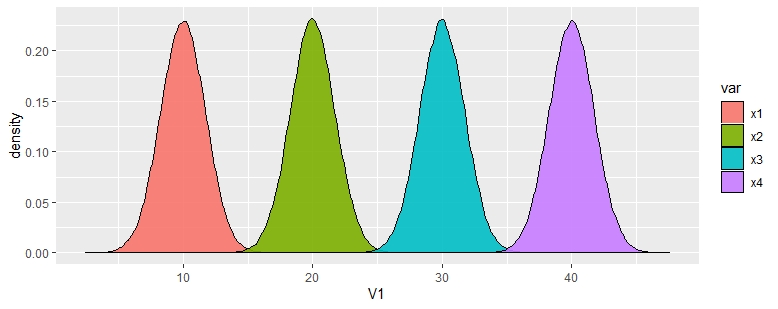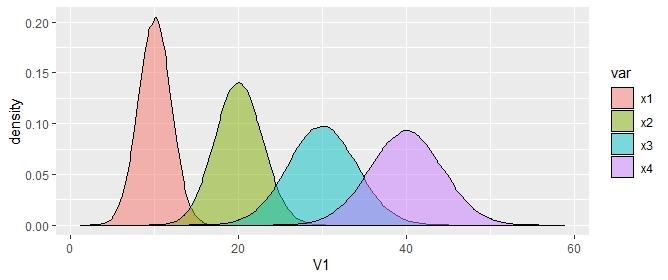You can get close to what you want by using a singular normal distribution - and if you use equal variances you will get equal negative pairwise correlations.
Using the transformation method (see guy's solution here r - pick 10 random numbers from standard normal distribution whose sum equals 5 for an example), we can find the covariace matrix (I've chosen 3 as the variance)
$$ \Sigma = \pmatrix{\ \ 3 & -1 & -1 & -1 \\
-1 & \ \ 3 & -1 & -1 \\
-1 & -1 & \ \ 3 & -1 \\
-1 & -1 & -1 & \ \ 3}.$$
Now we can use singular value decomposition (SVD) to generate the variates (see whuber's code here - Generating samples from singular Gaussian distribution)
Modifying whuber's code to suit your problem, we have:
library(MASS)
# Specify the mean vector for the multinormal distribution
mu <- c(10,20,30,40)
# Use equal variances, which leads to equal correlations
# of -1/3 among all pairwise combinations
sigma <- matrix(c(3.0,-1,-1,-1,-1,3.0,-1,-1,-1,-1,3.0,-1,-1,-1,-1,3.0),4,4) # Covariance matrix is singular
n <- dim(sigma)[1]
s <- svd((sigma + t(sigma))/2) # Guarantees symmetry
s$d <- abs(zapsmall(s$d))
m <- sum(s$d > 0)
# Generate normals in the lower dimension
n.sample <- 100000 # Number of realizations
x <- matrix(rnorm(m*n.sample),nrow=m)
# Embed in the higher dimension and apply square root
# of sigma obtained from its SVD
x <- rbind(x, matrix(0, nrow=n-m, ncol=n.sample))
y <- s$u %*% diag(sqrt(s$d)) %*% x + mu
# Prepare data for plotting
library(data.table)
x1 <- data.table(y[1,])
x2 <- data.table(y[2,])
x3 <- data.table(y[3,])
x4 <- data.table(y[4,])
# Add in label
x1$var <- 'x1'
x2$var <- 'x2'
x3$var <- 'x3'
x4$var <- 'x4'
all <- rbind(x1,x2,x3,x4)
# Plot histograms of the four components
ggplot(all, aes(V1, fill = var)) + geom_density(alpha = 0.9)
# Check a few totals
sum(y[1:4,1])
sum(y[1:4,2])
sum(y[1:4,10])
sum(y[1:4,n.sample])
sum(y)
# Check to see how close the empirical correlations are
# to negative 1/3
cor(y[1,],y[2,])
cor(y[1,],y[3,])
cor(y[2,],y[3,])
Here is the chart:

Here is output verifying the sum requirement for a few realizations and some of the empirical correlations:
> sum(y[1:4,1])
[1] 100
> sum(y[1:4,2])
[1] 100
> sum(y[1:4,10])
[1] 100
> sum(y[1:4,n.sample])
[1] 100
> sum(y)
[1] 1e+07
>
> # Check to see how close the empirical correlations are
> # to negative 1/3
> cor(y[1,],y[2,])
[1] -0.3294876
> cor(y[1,],y[3,])
[1] -0.331753
> cor(y[2,],y[3,])
[1] -0.336657
If you want to specify non-equal variances among your components, you will have a different covariance matrix. You will also not have equal pairwise correlations.
Part 2 - Unequal Variances
Suppose we want variances of 2, 3, 5, and 6.
If you use the following covariance matrix,
sigma <- matrix(c(3.7838,-0.4865,-1.3514,-1.9459,-0.4865,7.9054,-3.0405,-4.3784,-1.3514,-3.0405,16.5541,-12.1622,-1.9459,-4.3784,-12.1622,18.4865),4,4) # Covariance matrix is singular
You will get the following chart:

If this is of interest, I will post more on how to find the covariance matrix.



